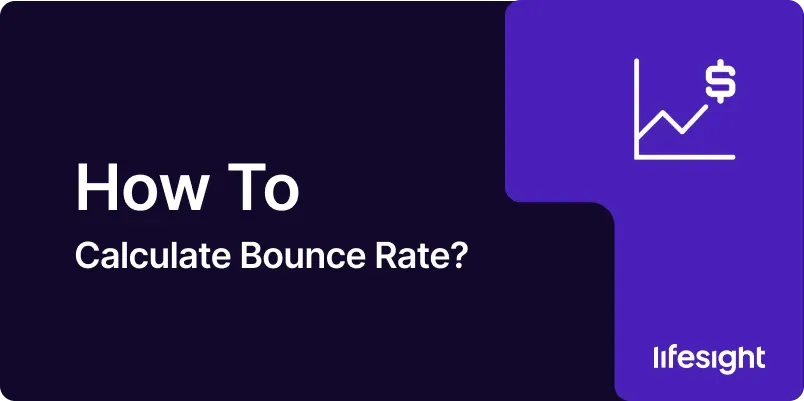
Introduction
In the digital age, understanding user behavior on your website is paramount to success. One of the key metrics that provides insight into this behavior is Bounce Rate. Whether you’re a digital marketer, website owner, or SEO specialist, understanding how to calculate and interpret Bounce Rate can provide valuable insights into your website’s performance and user engagement. This guide will walk you through the intricacies of Bounce Rate, from its basic calculation to its strategic implications and limitations.
Definitions of Key Terms
Before we delve into the calculation of Bounce Rate, let’s define some key terms:
- Bounce Rate: The percentage of single-page sessions where the person left your site from the entrance page without interacting with the page.
- Session: A group of user interactions with your website that take place within a given time frame.
- Single-page Session: A session where a user lands on your website and exits without triggering any additional requests to the Analytics server.
- Entrance Page: The first page viewed in a session.
- Exit Rate: The percentage of exits from a page divided by the number of page views of that page.
- Page Views: The total number of pages viewed on your site.
- Time on Page: The amount of time a user spends on a particular page.
- Engagement: Any interaction a user has with your page, such as clicking a link, playing a video, or filling out a form.
- Landing Page: A standalone web page, created specifically for a marketing or advertising campaign.
- Conversion: The completion of a desired action by a website visitor, such as making a purchase or filling out a form.
The Formula to Calculate Bounce Rate
The basic formula for calculating Bounce Rate is:
Bounce Rate = (Number of Single-Page Sessions / Total Number of Sessions) x 100%
Step-by-Step Guide to Calculating Bounce Rate
- Define Your Time Period: Decide on the period over which you want to measure Bounce Rate (e.g., daily, weekly, monthly).
- Count Single-Page Sessions: Tally the number of sessions where users viewed only one page before leaving.
- Count Total Sessions: Determine the total number of sessions for your website during the chosen time period.
- Apply the Formula: Divide the number of single-page sessions by the total number of sessions.
- Convert to Percentage: Multiply the result by 100 to get your Bounce Rate as a percentage.
Example Illustrating the Bounce Rate Formula
Let’s walk through a practical example to illustrate how to calculate Bounce Rate:
Suppose your website had the following data for the past month:
- Total number of sessions: 10,000
- Number of single-page sessions: 3,500
Applying the Bounce Rate formula:
Bounce Rate = (3,500 / 10,000) x 100% = 35%
This means that 35% of visitors left your site after viewing only one page.
What Bounce Rate is Used For and Why It’s Important
Bounce Rate is a crucial metric for several reasons:
- User Experience Indicator: It can indicate how well your site meets user expectations and needs.
- Content Relevance: High bounce rates might suggest that your content isn’t relevant to what users are looking for.
- Website Design Evaluation: It can highlight issues with website design or usability.
- Landing Page Effectiveness: For specific campaigns, it helps evaluate how well landing pages are performing.
- SEO Performance: Search engines may use bounce rate as a signal of content quality and relevance.
- Technical Issues Detection: Unusually high bounce rates might indicate technical problems with your site.
- Audience Alignment: It can help determine if you’re attracting the right audience to your site.
Where Bounce Rate Calculation is Applied
Bounce Rate calculations are applied across various digital contexts:
- E-commerce Websites: To evaluate product page effectiveness and overall site navigation.
- Blogs and Content Sites: To assess content engagement and relevance.
- Landing Pages: To measure the effectiveness of specific marketing campaigns.
- Business Websites: To evaluate how well the site is communicating the company’s value proposition.
- Online Portfolios: To see if visitors are exploring multiple projects or works.
- Educational Websites: To assess if users are engaging with multiple resources or courses.
- News Websites: To see if readers are exploring multiple articles.
- Mobile Apps: While traditionally a web metric, similar concepts can be applied to app usage.
- SaaS Platforms: To evaluate user onboarding and initial engagement.
- Non-profit Websites: To assess if visitors are exploring the organization’s various initiatives or donation options.
Limitations of Bounce Rate
While Bounce Rate is a valuable metric, it has several limitations:
- Doesn’t Account for Time Spent: A user might spend significant time on a single page before leaving, which would still count as a bounce.
- Varies by Industry and Page Type: What’s considered a “good” bounce rate can vary widely depending on the type of website and industry.
- Can be Misleading for Single-Page Sites: For sites designed to have all content on one page, a high bounce rate isn’t necessarily bad.
- Doesn’t Indicate Why Users are Bouncing: The metric doesn’t provide reasons for why users are leaving.
- Can be Affected by Technical Issues: Improper setup of analytics tools can lead to inaccurate bounce rates.
- Doesn’t Account for Return Visits: If a user bounces but returns later, this positive behavior isn’t reflected in the bounce rate.
- Can be Skewed by Bot Traffic: Non-human traffic can artificially inflate bounce rates.
- Doesn’t Reflect Quality of Engagement: A user might have a meaningful interaction with a page before leaving, which would still count as a bounce.
- Can be Manipulated: Site owners might implement tactics to artificially lower bounce rates without improving user experience.
- Doesn’t Account for External Factors: Things like source of traffic or device type can significantly impact bounce rate but aren’t reflected in the basic metric.
Factors Impacting Bounce Rate
Several factors can significantly impact your Bounce Rate:
- Page Load Speed: Slow-loading pages often lead to higher bounce rates.
- Content Relevance: How well your content matches user intent and expectations.
- Website Design: User-friendly design and intuitive navigation can lower bounce rates.
- Mobile Responsiveness: Poor mobile experience can increase bounces from mobile users.
- Traffic Source: Different traffic sources (e.g., organic search, paid ads, social media) can have different bounce rates.
- User Intent: Informational queries might naturally have higher bounce rates than transactional ones.
- Technical Issues: Broken links, error pages, or other technical problems can increase bounces.
- Pop-ups and Interstitials: Intrusive elements can drive users away quickly.
- Content Format: How your content is presented (text, video, interactive elements,email) can affect engagement.
- External Links: Having too many prominently placed external links might lead users away from your site.
Other Strategies for Assessment
While Bounce Rate is important, it should be used alongside other metrics for a comprehensive assessment:
- Average Session Duration: Measures how long users typically spend on your site.
- Pages per Session: Indicates how many pages users view in a single session.
- Conversion Rate: Measures the percentage of users who complete a desired action.
- Exit Rate: Shows which pages users most commonly leave your site from.
- Return Visitor Rate: Indicates how many of your visitors are coming back to your site.
- Page Depth: Measures how far into your site users typically navigate.
- User Flow: Visualizes the path users take through your site.
- Heat Maps: Show where users are clicking and scrolling on your pages.
- Form Completion Rate: For sites with forms, measures how many users start and complete forms.
- Site Speed Metrics: Various metrics that measure how quickly your site loads and becomes interactive.
The Relationship Between Bounce Rate and Other Metrics
Understanding how Bounce Rate relates to other metrics provides a more comprehensive view of website performance:
- Bounce Rate and Time on Page: A high bounce rate with a high time on page might indicate engaging content that doesn’t encourage further site exploration.
- Bounce Rate and Conversion Rate: Generally, lower bounce rates correlate with higher conversion rates, but this isn’t always the case.
- Bounce Rate and Exit Rate: While related, exit rate can provide more context about which specific pages are causing users to leave.
- Bounce Rate and Pages per Session: These are inversely related; as pages per session increase, bounce rate typically decreases.
- Bounce Rate and SEO Rankings: While not a direct ranking factor, bounce rate can indirectly affect SEO performance.
- Bounce Rate and Advertising Quality Score: In pay-per-click advertising, high bounce rates can negatively impact quality scores.
- Bounce Rate and Load Time: There’s often a positive correlation between slow load times and high bounce rates.
Benefits of Calculating Bounce Rate
Regularly calculating and analyzing Bounce Rate offers numerous benefits:
- User Experience Insights: Provides a quick indicator of how well your site is meeting user expectations.
- Content Strategy Refinement: Helps identify which types of content are most engaging to your audience.
- Website Design Optimization: Can highlight potential issues with site navigation or design.
- Marketing Campaign Evaluation: Helps assess the effectiveness of landing pages for specific campaigns.
- SEO Improvement: Can indicate potential issues with keyword targeting or meta descriptions.
- Technical Issue Identification: Sudden changes in bounce rate can alert you to potential technical problems.
- Audience Targeting Refinement: Helps ensure you’re attracting the right audience to your site.
- Competitive Benchmarking: Allows you to compare your site’s performance against industry standards.
- Conversion Funnel Optimization: By reducing bounce rate, you can get more users into your conversion funnel.
- Resource Allocation: Helps prioritize which areas of your site need the most attention for improvement.
Conclusion
Bounce Rate is a powerful metric that provides crucial insights into user behavior and website performance. By mastering the calculation and interpretation of Bounce Rate, digital marketers, website owners, and SEO specialists can make data-driven decisions to improve user experience, increase engagement, and ultimately drive better business results.
However, it’s important to remember that while Bounce Rate is valuable, it should not be used in isolation. Combining Bounce Rate analysis with other performance metrics, considering its limitations, and placing it in the broader context of your website goals and user intent will provide a more comprehensive view of your digital performance.
As user behaviors and web technologies continue to evolve, so too will the strategies for calculating and interpreting Bounce Rate. Staying informed about new analytics methodologies, changing user expectations, and emerging best practices will be crucial for maintaining a competitive edge in the digital landscape.
By regularly calculating, analyzing, and acting on Bounce Rate data, businesses can ensure they’re creating engaging, user-friendly digital experiences that not only attract visitors but keep them coming back for more.
Free essential resources for success
Discover more from Lifesight
















